In 1894 Colt debuted a target variation of its Single Action Army pistol (SAA) called the Bisley. This new revolver was named after the famous British shooting range in Surry, England. Colt manufactured more than 44,000 Bisley revolvers in 18 different chamberings, with barrel lengths of 4.75, 5.5, and 7.5 inches, until 1915, when the company discontinued the line. A very small number had adjustable sights, but most had fixed sights like the SAA. The Bisley used the same frame, barrel, ejector-rod system, and cylinder, as well as the basic mechanism of the SAA, but the new gun also offered some distinct differences — namely the hammer, trigger, and grip, which were designed for the late-19th-century target shooter. Some internal parts like the mainspring, hand, racket, and others were also different.
The shape of the Bisley grip is swept under and appears more vertical than the traditional SAA, and that’s for a reason: To accommodate a bent-arm single-hand hold, which for today’s shooter looks and feels archaic. Obviously, one can shoot a Bisley like any modern pistol by keeping the wrist locked with a one-hand or two-hand grip, like with modern semi-automatic pistols such as the 1911, Glock, and the ilk. But the Bisley’s grip doesn’t lend itself to this modern hold.
Also, the Bisley’s trigger is wider than the traditional SAA, the trigger guard is shaped differently, and the hammer spur was lowered to make it easier to cock without a shooter needing to loosen his grip.
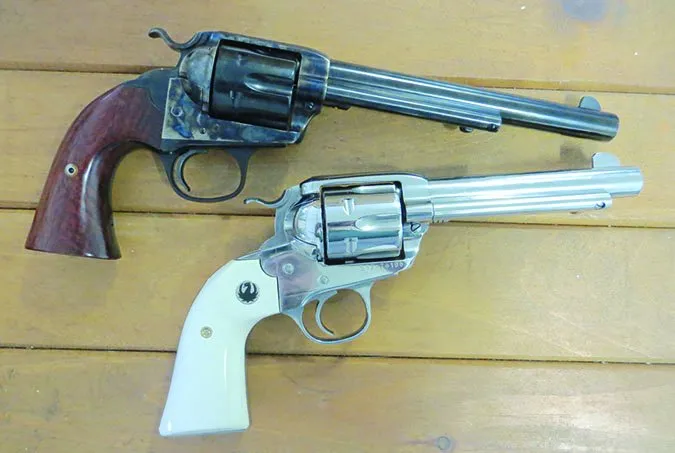
Ruger refreshed the Bisley in 1984, introducing the Ruger Blackhawk Bisley with a similar unique grip, but not as tucked as the original Colt, and with target sights and an engraved unfluted cylinder. The Ruger Bisley grip design allows for less movement of the grip in hand when firing hot loads. Unlike a SAA grip style, which curls up in your hand when firing hot loads, the Bisley transfers the recoil into the palm of the hand, a more comfortable experience when shooting hot loads. A Bisley of one type or another has been in Ruger’s catalog ever since.
We wanted to take a look at an old-school Bisley and a modern Bisley to compare them side by side, so we acquired an Uberti Cattleman Bisley, which is a spitting image of an original Colt, and the more modern variant in a Ruger Bisley Vaquero, built on the New Vaquero frame. Our first task was to use a revolver range rod and rod-head combo from Brownells in 38 Special/357 Magnum (080-617-038WB, $40) to check each chamber for alignment with the bore, and we found everything to be in spec. Some older replica revolvers might have had the throat of a chamber opened up to accept a range rod during factory inspection, which means that particular chamber will shave and spit lead and be less accurate than other chambers. The range rod won’t pick up this issue.
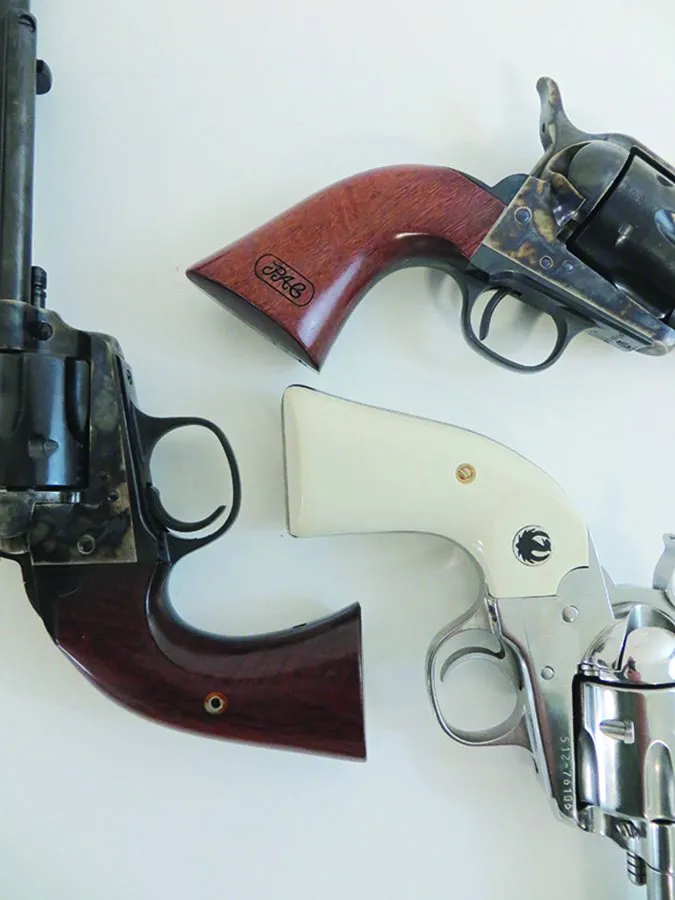
Newer CNC machines hold better tolerances, and we did not experience any spitting or shaved lead with the Uberti replica nor the Ruger, nor did we expect it. We mention it only because we thought it prudent to let readers know that some older manufactured replica revolvers on the used market may exhibit this problem. We also used a feeler gauge to check the barrel/cylinder clearance, and we found that the Ruger was tighter at .004 inches compared to the Uberti’s .008 inches. The tighter Ruger, even with a 5.5-inch barrel, gave slightly higher muzzle velocities than the Uberti with the larger gap and 7.5-inch barrel. The recommended gap for lubed lead bullets is .008 inches and .006 inches for jacketed bullets. Not that we think it is an issue, but extensive lead shooting without cleaning may cause the cylinder to bind, so Cowboy Action shooters take note, especially if you load black-powder cartridges. Clymer Go (184-100-380WB) and No-Go (184-100-381WB) gauges, both $30 from Brownells, were used in the cylinder chambers to check headspace. We do this with the Go gauge to ensure factory ammo will chamber and allow the cylinder to rotate freely. If a No-Go gauge can be rotated in the cylinder, the headspace is too long and out of spec, and it becomes a potentially dangerous revolver to shoot. We assumed the Uberti and Ruger would pass without incident, and they did.
We also field-stripped the revolvers to get a better sense of their ease of disassembly and manufacturing. We found the fit and finish for both were well executed, and the timing on both Bisley revolvers was near perfect.
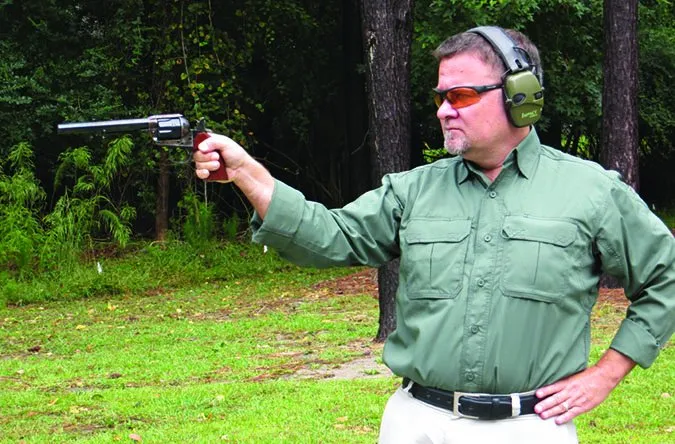
To test for function, feel, and accuracy, we tried a variety of standard 38 Special and 38 Special +P loads as well as a 357 Magnum set. What we found was that these old-style revolvers shot well. Across all ammo brands and types, we averaged about 1.5-inch 5-shot groups at 25 yards using a rest. Those older-style sights may not be as easy to use as more modern sights, but with some practice by the shooter, they sure can get the job done.
Depending on what you prefer, you will either like the more traditionally styled revolver or the modern update, but for most of our shooters, the Ruger Bisley came out on top, and you will see why shortly. Here’s more on the Bisley match up.
Uberti Cattleman Bisley 346040 38 Special/357 Magnum, $609
If holding to tradition is important to you, then the Uberti Cattleman Bisley has a place in your gun safe. This is a well-made, beautiful revolver that offers good performance at $200 less than the Ruger. The barrel, cylinder, and grip frame are all deeply blued with a rich case-hardened frame color. The smooth walnut grips had nice figuring and were well fitted to the metal.
The blue-blood Colt collectors winced at the Uberti because it was not truly a clone of a Colt, but it was a darned good replica. Small touches, such as the checkered hammer spur, help redeem it in their eyes, though the firing pin was obviously not the cone-shaped firing pin of an original. The Uberti made the same music when cocking as does a traditional SAA. It uses the same type of mechanism, with a half cock notch for loading and unloading. As a result, the Uberti needs to have the hammer rest on an empty chamber when carried.
What was modernized on the Uberti was the elongated cylinder base pin, which has two notches in lieu of one. The shooter can press the base pin screw and push in the cylinder base pin to the first notch to block the hammer from fully moving forward and firing a round. This is not a solution for carrying the Uberti fully loaded, we believe. Instead, we recommend using the “load one, skip one” method like a shooter does with a traditional SAA.
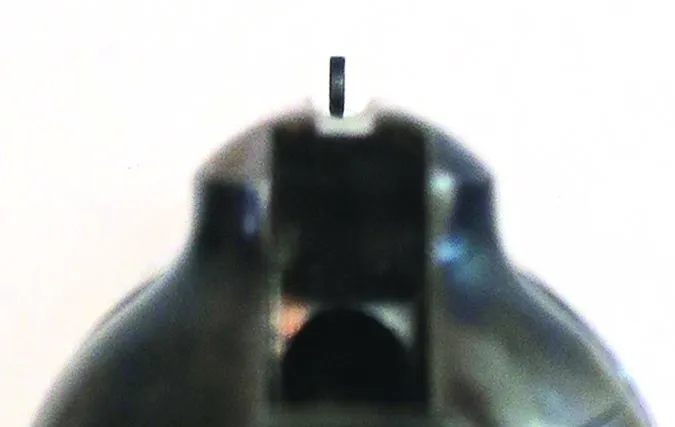
The ejector-rod head is crescent shaped and rotates away from the barrel so finger tips do not get singed. This is a feature on traditional SAA revolvers testers have come to appreciate. The Uberti has a rounded front-blade sight and the traditional grooved rear milled into the top strap. When cocked, the rear of the groove is flat and dark. We found we liked these sights as is, especially because the Uberti shot to point of aim. In fact, with a rest, some testers were able to cluster shots with holes touching, especially with the 38 Special ammo.
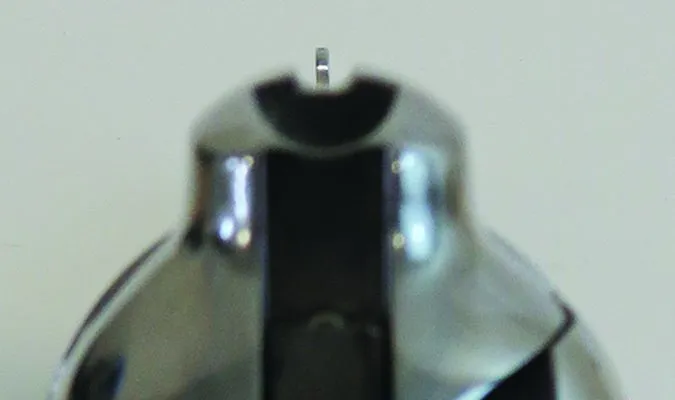
In hand, the Uberti felt lighter and more compact than the Ruger. The grip was a bit odd; thinner directly behind the trigger guard than the Vaquero. Many testers liked the fuller Ruger Bisley grip, which filled this thinner area. Again, this is due to the Uberti keeping with the original design of the Bisley grip. We did fire a number of rounds like late-19th-century target shooters, and found in 38 Special, the stance was fine, though awkward. Using 357 Magnums, however, required a more modern stance. The felt recoil with the Hydra-Shok loads was quite manageable. We also felt the Uberti was easier to cock. It had a similar trigger-pull weight as the Ruger, and both had no creep and a crisp let off.
Our Team Said: The Uberti was as close to an original Bisley as you can get, and we thought it was a steal compared to the price of the Ruger. The grip, however, felt a bit off for modern shooters, and that was what knocked the Uberti behind the Ruger.
Ruger Bisley Vaquero 5130 38 Special/357 Magnum, $835
The Ruger Bisley New Model Vaquero offers the unique Bisley look plus many modern refinements that make shooting these revolvers safer and more user friendly. Our Ruger Bisley featured a 5.5-inch barrel, simulated ivory grip, and a polished stainless-steel finish that resembled nickel plating, but with none of the wear and maintenance requirements that finish requires. If the glossy, bright finish has a drawback, it is sun glare when shooting under a clear sky. On the other hand, the stainless finish made it easy to clean the revolver after extended shooting sessions. Testers agreed they would darken the shooter-facing position of the front blade and the semi-circular cutout just to the rear of the groove on the top strap.
The grip is reminiscent of the original Bisley, but it felt more friendly to the modern shooter, in our view. It is not as swept under as it is on an original Colt, so in hand, the Ruger Bisley felt much like a modern semi-automatic pistol. Shot one- or two-handed, the Ruger felt comfortable. We found it delightfully addictive to shoot with mild 38 Special loads, and quite comfortable and easy to manage with hot 357 Magnum loads.
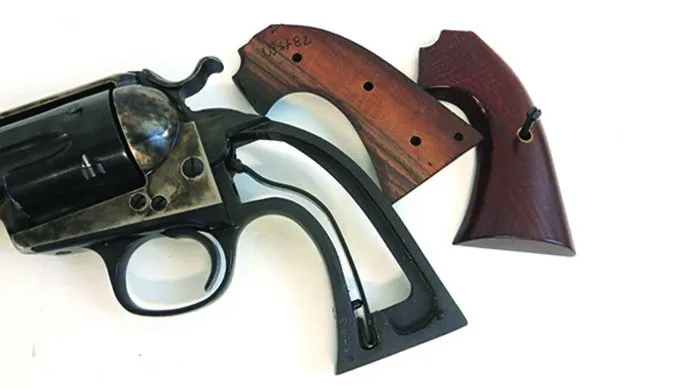
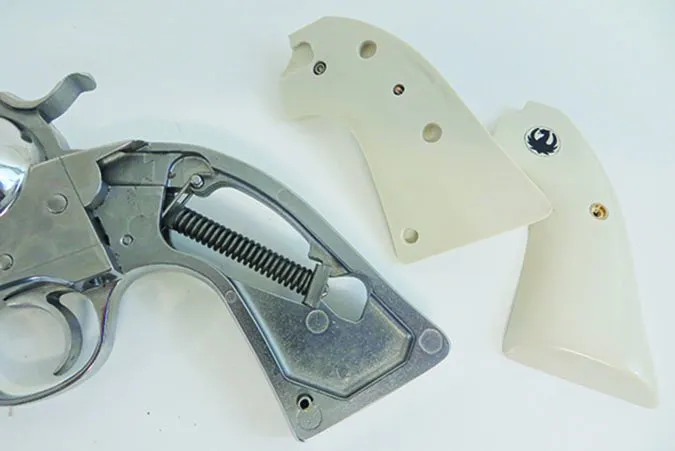
The grip panels were an off-white polymer that looked like ivory. The Ruger medallion was inset in each grip panel. The panels were not flush with the frame like on the Uberti, but the edges were smooth, so no chafing occurred during live-fire testing. In hand, the Ruger had a bit of heft to it — 45 ounces — compared to the 7.5-inch barrel Uberti that weighed 47.7 ounces. The Ruger was a natural pointer that we found comfortable to hold, grip, and cock, due to the Bisley’s lowered hammer. Testers did not have to break their grips to cock the piece like with a traditional SAA.
Features found in the Vaquero series are incorporated into the Bisley, such the transfer safety-bar system, which allows the Bisley to be safely carried with all chambers loaded, unlike the Uberti, which must be carried with the hammer on an empty chamber. The Ruger also uses a reverse indexing pawl to make loading and unloading the Ruger Bisley easier. If you pass the chamber, then just rotate it backwards a bit to align the chamber and loading gate. With the Uberti and other traditional SAA revolvers, if you rotate the cylinder past the chamber, the cylinder needs to be completely spun around to get back to the missed chamber and re-aligned with the loading gate.
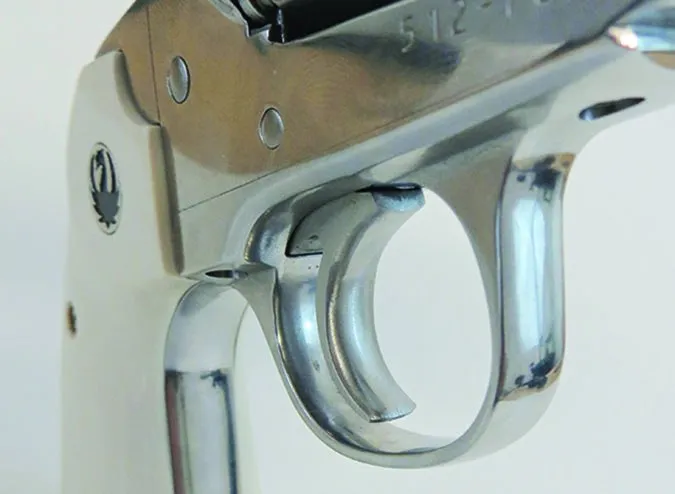
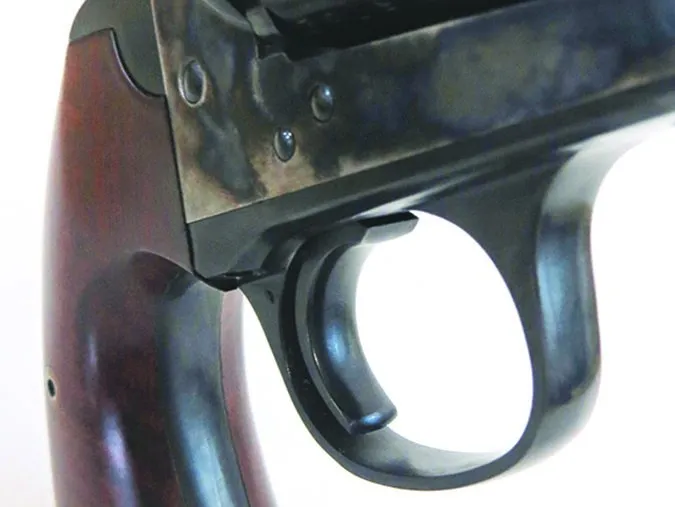
The other features that make the Ruger a Bisley is the rounded trigger guard, curved trigger, and lowered hammer spur. The ejector rod head is crescent-shaped and does not pivot away from the barrel in use. Watch out for singed finger tips after extensive shooting heats up the barrel. The front of the cylinder is beveled to aid holstering. Loading the Ruger Bisley is also modernized. The hammer and trigger must be fully forward, and with the loading gate opened, the cylinder rotates freely. There is no half cock on the hammer as in a traditional SAA and in the Uberti Bisley. The Ruger’s hammer took slightly more effort to cock than the Uberti, and we attribute that to the Ruger’s coiled mainspring. The Uberti has a traditional flat mainspring.
The Ruger’s trigger consistently broke at 3.8 pounds, which we thought was fine for this revolver. The Bisley also shot to point of aim, an important attribute for any SAA-style revolver with fixed sights. At 25 yards, we found shooting a 2-inch group to be easy, even if the sights were hard to see in some light conditions. At 7 and 15 yards, the Ruger showed its stuff with good accuracy at fast speeds. Loaded for bear with the Federal Tactical 158-grain Hydra-Shok JHPs, recoil was quite manageable since the grip is wide and spread felt recoil to more area of the palm. For most shooters, the middle finger did not get whacked, which can happen on traditional SAA revolvers when firing magnum loads.
Our Team Said: The Ruger shot to point of aim, had a very serviceable grip, and its heft made shooting hot loads tolerable. Testers felt more confident with the Ruger due to the modern Bisley-esque grip shape. The sights needed to be blackened to perform better. The transfer bar system gave it a leg up on the Uberti in terms of safety — so with all that considered, we’d buy it ahead of the Uberti Cattleman.
Written and photographed by Robert Sadowski, using evaluations from Gun Tests team testers.



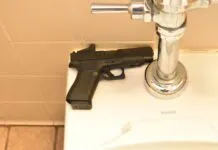


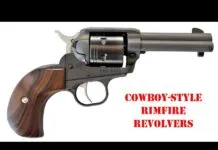























I bought the 357 used and love it. It feels gr8, shoots gr8 and looks gr8. I love this gun, there is no kick to it because it’s so heavy but very well balanced. Just my experience.
The Ruger “Bisley” should be called the Keith because it more closely mimics Elmer Keith’s revolver# 5 than a Colt Bisley. The #5 grip was fashioned to manage Elmer’s penchant for hot rod 44 special loads. I love the Ruger grip but the name is unfortunate.